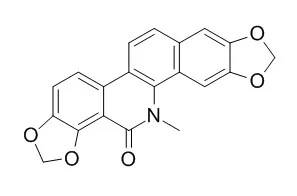| In vitro: |
| J Vector Borne Dis. 2017 Jul-Sep;54(3):255-262. | | Computer-aided analysis of phytochemicals as potential dengue virus inhibitors based on molecular docking, ADMET and DFT studies.[Pubmed: 29097641] | Dengue fever, caused by dengue virus (DENV), has become a serious threat to human lives. Phytochemicals are known to have great potential to eradicate viral, bacterial and fungal-borne diseases in human beings. This study was aimed at in silico drug development against nonstructural protein 4B (NS4B) of dengue virus 4 (DENV4).
METHODS AND RESULTS:
A total of 2750 phytochemicals from different medicinal plants were selected for this study. These plants grow naturally in the climate of Pakistan and India and have been used for the treatment of various pathologies in human for long-time. The ADMET studies, molecular docking and density functional theory (DFT) based analysis were carried out to determine the potential inhibitory properties of these phytochemicals. The ADMET analysis and docking results revealed nine phytochemicals, i.e. Silymarin, Flavobion, Derrisin, Isosilybin, Mundulinol, Silydianin, Isopomiferin, Narlumicine and Oxysanguinarine to have potential inhibitory properties against DENV and can be considered for additional in vitro and in vivo studies to assess their inhibitory effects against DENV replication. They exhibited binding affinity ≥ -8 kcal/mol against DENV4-NS4B. Furthermore, DFT based analysis revealed high reactivity for these nine phytochemicals in the binding pocket of DENV4-NS4B, based on ELUMO, EHOMO and band energy gap. INTERPRETATION &
CONCLUSIONS:
Five out of nine phytochemicals are reported for the first time as novel DENV inhibitors. These included three phytochemicals from Silybum marianum, i.e. Derrisin, Mundulinol, Isopomiferin, and two phytochemicals from Fumaria indica, i.e. Narlumicine and Oxysanguinarine. However, all the nine phytochemicals can be considered for in vitro and in vivo analysis for the development of potential DENV inhibitors. | | Planta Med. 1999 Oct;65(7):643-7. | | New tetrahydroprotoberberine N-oxide alkaloids and cytotoxic constituents of Corydalis tashiroi.[Pubmed: 17260290 ] |
METHODS AND RESULTS:
Three new tetrahydroprotoberberine N-oxide alkaloids, (-)- cis-corydalmine N-oxide, (-)- trans-corydalmine N-oxide, and (-)- trans-isocorypalmine N-oxide, along with three known benzo[ C]phenanthridine alkaloids, norsanguinarine, dihydrosanguinarine, and Oxysanguinarine, six known berberine alkaloids, (-)-tetrahydropalmatine, (-)-corydalmine, (-)-scoulerine, (-)-corynoxidine, (-)-epicorynoxidine, palmatine, and protopine, have been isolated from the herb Corydalis tashiroi.
CONCLUSIONS:
The structures of these compounds were elucidated by spectroscopic analysis. Three of the isolated compounds show significant cytotoxic activities (ED (50) values < 4 microg/ml) against P-388, KB16, A549, and HT-29 cell lines. |
|






 Cell. 2018 Jan 11;172(1-2):249-261.e12. doi: 10.1016/j.cell.2017.12.019.IF=36.216(2019)
Cell. 2018 Jan 11;172(1-2):249-261.e12. doi: 10.1016/j.cell.2017.12.019.IF=36.216(2019) Cell Metab. 2020 Mar 3;31(3):534-548.e5. doi: 10.1016/j.cmet.2020.01.002.IF=22.415(2019)
Cell Metab. 2020 Mar 3;31(3):534-548.e5. doi: 10.1016/j.cmet.2020.01.002.IF=22.415(2019) Mol Cell. 2017 Nov 16;68(4):673-685.e6. doi: 10.1016/j.molcel.2017.10.022.IF=14.548(2019)
Mol Cell. 2017 Nov 16;68(4):673-685.e6. doi: 10.1016/j.molcel.2017.10.022.IF=14.548(2019)